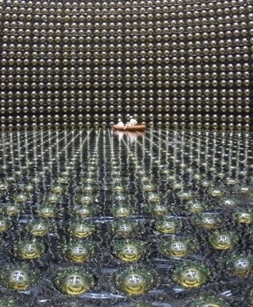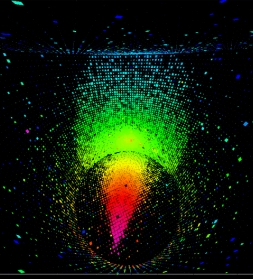

Research indicates that subatomic particles called neutrinos may have a previously unseen form of identity-shifting property - News
by Simon Levey
17 June 2011
Research from the UK and Japan indicates that subatomic particles called neutrinos may have a previously unseen form of identity-shifting property. Announced this week, these results could one day help scientists explain why the universe contains matter, but very little antimatter.
See also:
- T2K
- Science and Technology Facilities Council (STFC)
- Watch a video of Professor Wark talking about the findings
Related news stories:
The new findings are the first from the T2K neutrino experiment in Japan and they show neutrinos changing between different types, or oscillating, in a third way where they had previously only been seen oscillating in two ways. Professor Dave Wark from the High Energy Physics group at Imperial College London leads the UK's involvement in the international experiment.
The new results from T2K mean it is possible that neutrinos oscillate in a different way to their antimatter particles (called anti-neutrinos). Equal amounts of matter and antimatter were thought to have existed at the start of the universe but now everything that we know is made of ordinary matter. If the new results are proven to be true, the differences between neutrinos and anti-neutrinos could help explain how all the antimatter has disappeared from the universe, leaving only ordinary matter.
There are three types, or ‘flavours,’ of neutrinos – one paired with the electron (called the electron neutrino), and two more paired with the electron’s heavier cousins, the muon and tau leptons. These different flavours of neutrinos can spontaneously change into each other, a phenomenon called neutrino oscillation, two types of which have been confirmed by other experiments, but until now the third had not been seen.
To explore the neutrinos’ oscillations, the T2K experiment fired a beam of neutrinos from the J-PARC laboratory at Tokai Village on the eastern coast of Japan, and detected them at the Super-Kamiokande neutrino detector, 295 km away in the mountains of the north-western part of the country. Here, the scientists looked to see if the neutrinos at the end of the beam matched those emitted at the start.

Physicists working inside the Super Kamiokande neutrino detector in Japan
They found six electron neutrinos appearing in the beam of muon neutrinos, where they only expected to see an average of between one and two. This indicates evidence for the third type of oscillation and has led the team to say they have now observed neutrinos oscillating in every way they expect to be possible.
The likelihood of making an observation such as this by chance is about one time in a hundred, so the researchers say this result is not statistically significant enough to confirm a new physics 'discovery'. Instead, they are calling this an 'indication'.
Professor Wark said: "People sometimes think that scientific discoveries are like light switches that click from 'off' to 'on', but in reality it goes from 'maybe' to 'probably' to 'almost certainly' as you get more data. Right now we are somewhere between 'probably' and 'almost certainly'"
The experiment ran from January 2010 until 11 March this year, when it was dramatically interrupted by the Japanese earthquake. Fortunately, the T2K team were unharmed and their highly sensitive detectors were largely undamaged.

A representaion of the results produced by particles passing through the neutrino detector
Professor Christos Touramanis from Liverpool University, who is the Project Manager for the UK contributions to T2K, said: "We have examined the near detectors and turned some of them back on, and everything that we have tried works pretty well. So far it looks like our earthquake engineering was good enough, but we never wanted to see it tested so thoroughly."
The Science and Technology Facilities Council (STFC) is the UK sponsor of particle physics and supports the UK universities involved in the T2K experiment.
Watch a video of Professor Wark talking about the findings at the STFC website.
Article text (excluding photos or graphics) available under an Attribution-NonCommercial-ShareAlike Creative Commons license.
Photos and graphics subject to third party copyright used with permission or © Imperial College London.





